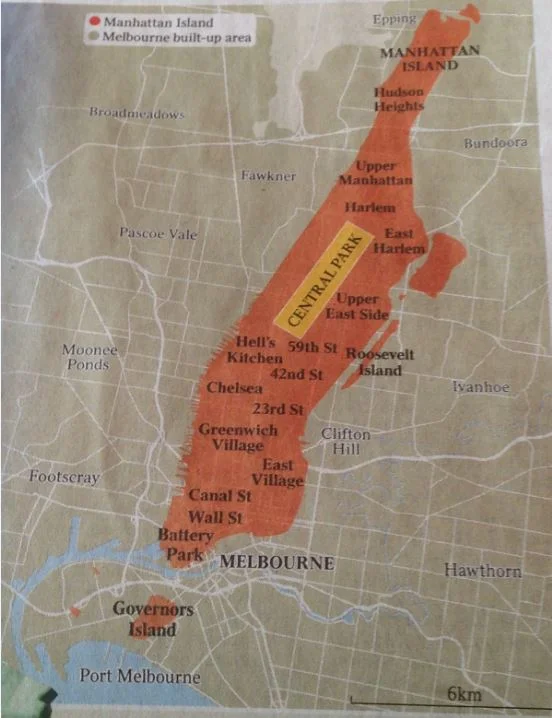Innovative ideas spill over from density’s diversity
With thanks to Bernard Salt. Original picture was sourced from KPMG Demographics, Australia
Originally published on December 19, 2016. Updated October 09, 2017.
Do our modern lifestyles actually help people to become innovative and creative? After thinking about shopping centres (https://www.soupthink.com/blog-page/2017/8/27/retail-developers-in-australia-are-living-on-borrowed-time)and other topics recently, I got to wondering about how this plays out on a broader level.
The third principle in Carmine Gallo’s audiobook “The Innovation Secrets of Steve Jobs” (https://www.youtube.com/watch?v=Q0asm1KBRs4) notes that our brains are built to conserve energy; to run as efficiently as possible. For example (thankfully!) we don’t need to consciously tell ourselves to breathe. But this also means that our brains are hard-wired to developing habits, and why thinking creatively can be such hard work.
Gallo goes on to suggest that one of the most powerful ways to teach our brains to become more creative or innovative is to bombard them with new experiences. In doing so, we force our brains to create new neural pathways – and both literally and in terms of ideas – we make new connections.
This concept of exposing ourselves to new things may be a cornerstone to innovation. However, very little in our existing social and economic structures makes the connection between how we approach each day, and how we can actually become innovative and creative.
After all, innovation and creativity are not (generally) taught in schools, or at least not to the extent needed yet. And our existing social structures often impede it – including our built environment. We arguably have more freedom than at any other time in human history. But many of us act like mice who don’t understand that the cage door is now open.
Do most of us actually learn how to innovate in our daily lives?
I’d argue that we don’t. First of all, we have become used to buying the answers to problems, instead of having to work them out ourselves. As a result, our innovative/creative abilities don’t necessarily get much exercise.
People now wake up in the morning, and food and water are available. Transport is pretty straightforward, as is communication with people across the city, or around the world. While we use our brains at work and school, we do so within pretty narrow boundaries. In a work setting, we are often specialists – and so our recognized skills are the ones we hone. Mistakes and experiential learning are often discouraged – that costs money – and so we slowly learn to stop having ideas.
Outside of work, we tend to spend most time with people who are similar to ourselves. Likewise, we gravitate towards information sources that match our existing view of the world. Some of us read newspapers, others read beauty magazines, and some people read both. This is our brains at work again, finding the social and media equivalents of the easiest, most efficient connections.
What does all of this mean for our brains? Well, I’d argue that exposure to new ideas, or new ways of doing things is rare for many of us. Besides, the connections formed in our brains from reading differ from those connections created when we physically try something. This is not to say that a whole heap of stuff to try out doesn’t exist – it does. But many of us don’t do it proactively very often – and I include myself in that.
Why does this matter, though?
Well, it is not an accident that the centres of Australia’s capital cities are the nation’s most productive and innovative locations. The flip side of this trend is that other regions are falling behind economically: http://www.smh.com.au/nsw/a-state-divided-parts-of-nsw-recessionhit-as-sydney-booms-20161129-gszvwz.html
Many businesses understand the need to innovate, because they compete against other firms that do. The same goes for start-up companies, who know it’s the only way to get traction and sales. But does the average person see a role for themselves in being innovative?
I’d say that they don’t. Rather, it seems that for many voters across the world, “innovation” equates to losing one’s job. The tragedy is that if people don’t learn how to innovate, then their livelihoods are probably at risk. Whether we like it or not, the politicians are right; our standard of living depends upon innovation. Any job that involves doing things by rote is at risk of digitalization or outsourcing.
This is already happening. There are increasingly more jobs available for people with higher education and (non-routine) skills http://www.canberratimes.com.au/business/workplace-relations/where-the-jobs-are-and-where-they-arent-20161027-gsc26l.html.
How does this relate to cities?
Bernard Salt’s recent article (http://tinyurl.com/hhd2nuy (paywall)) compares the population density in Australian cities to some of the world’s most innovative cities. Dense cities allow people from many different lifestyles regularly come into contact with each other. In such cities, architects make small talk with nurses, and construction workers meet artists on a daily basis. In these surroundings, people are more likely to have their views of the world challenged – and expanded.
By comparison, in suburban areas, low density limits this type of social interaction. As such, suburban environments may well be limiting our collective ability to be creative or innovative. This is because it encourages us into (quite literally) path dependence.
Do any of these patterns sound familiar to you:
- travelling the same routes to and from work each day, with limited human contact on the commute?
- commuting while looking at or listening to electronic devices?
- attending existing sports clubs and hobbies, and generally mixing with people you already know?
I’m not suggesting that everyone should move to denser locations, or that doing so will make everyone instantly creative or innovative. Nor am I arguing that such attributes are impossible to come by in suburban areas. But if we want to solve problems, then greater awareness of how our environments impact upon us could be useful. And so could the idea of proactive exposure to new ideas and experiences.
What do you think? Let me know in the comments below!








